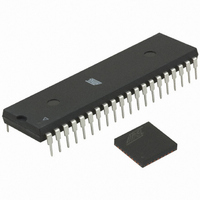ATMEGA64RZAV-10PU Atmel, ATMEGA64RZAV-10PU Datasheet - Page 256

ATMEGA64RZAV-10PU
Manufacturer Part Number
ATMEGA64RZAV-10PU
Description
MCU ATMEGA644/AT86RF230 40-DIP
Manufacturer
Atmel
Series
ATMEGAr
Datasheets
1.ATMEGA644-20MU.pdf
(23 pages)
2.ATMEGA644-20MU.pdf
(376 pages)
3.AT86RF230-ZU.pdf
(98 pages)
Specifications of ATMEGA64RZAV-10PU
Frequency
2.4GHz
Modulation Or Protocol
802.15.4 Zigbee
Power - Output
3dBm
Sensitivity
-101dBm
Voltage - Supply
1.8 V ~ 3.6 V
Data Interface
PCB, Surface Mount
Memory Size
64kB Flash, 2kB EEPROM, 4kB RAM
Antenna Connector
PCB, Surface Mount
Package / Case
40-DIP (0.600", 15.24mm)
Wireless Frequency
2.4 GHz
Interface Type
JTAG, SPI
Output Power
3 dBm
For Use With
ATSTK600-TQFP32 - STK600 SOCKET/ADAPTER 32-TQFPATAVRISP2 - PROGRAMMER AVR IN SYSTEMATSTK500 - PROGRAMMER AVR STARTER KIT
Lead Free Status / RoHS Status
Lead free / RoHS Compliant
Operating Temperature
-
Applications
-
Data Rate - Maximum
-
Current - Transmitting
-
Current - Receiving
-
Lead Free Status / Rohs Status
Lead free / RoHS Compliant
For Use With/related Products
ATmega64
- Current page: 256 of 376
- Download datasheet (8Mb)
22.4
22.5
256
Using the Boundary-scan Chain
Using the On-chip Debug System
ATmega644
• Apply the TMS sequence 1, 1, 0 to re-enter the Run-Test/Idle state. The instruction is latched
• At the TMS input, apply the sequence 1, 0, 0 at the rising edges of TCK to enter the Shift Data
• Apply the TMS sequence 1, 1, 0 to re-enter the Run-Test/Idle state. If the selected Data
As shown in the state diagram, the Run-Test/Idle state need not be entered between selecting
JTAG instruction and using Data Registers, and some JTAG instructions may select certain
functions to be performed in the Run-Test/Idle, making it unsuitable as an Idle state.
Note:
For detailed information on the JTAG specification, refer to the literature listed in
on page
A complete description of the Boundary-scan capabilities are given in the section
(JTAG) Boundary-scan” on page
As shown in
• A scan chain on the interface between the internal AVR CPU and the internal peripheral units.
• Break Point unit.
• Communication interface between the CPU and JTAG system.
All read or modify/write operations needed for implementing the Debugger are done by applying
AVR instructions via the internal AVR CPU Scan Chain. The CPU sends the result to an I/O
memory mapped location which is part of the communication interface between the CPU and the
JTAG system.
The Break Point Unit implements Break on Change of Program Flow, Single Step Break, two
Program Memory Break Points, and two combined Break Points. Together, the four Break
Points can be configured as either:
• 4 single Program Memory Break Points.
• 3 Single Program Memory Break Point + 1 single Data Memory Break Point.
• 2 single Program Memory Break Points + 2 single Data Memory Break Points.
• 2 single Program Memory Break Points + 1 Program Memory Break Point with mask (“range
• 2 single Program Memory Break Points + 1 Data Memory Break Point with mask (“range Break
onto the parallel output from the Shift Register path in the Update-IR state. The Exit-IR, Pause-
IR, and Exit2-IR states are only used for navigating the state machine.
Register – Shift-DR state. While in this state, upload the selected Data Register (selected by
the present JTAG instruction in the JTAG Instruction Register) from the TDI input at the rising
edge of TCK. In order to remain in the Shift-DR state, the TMS input must be held low during
input of all bits except the MSB. The MSB of the data is shifted in when this state is left by
setting TMS high. While the Data Register is shifted in from the TDI pin, the parallel inputs to
the Data Register captured in the Capture-DR state is shifted out on the TDO pin.
Register has a latched parallel-output, the latching takes place in the Update-DR state. The
Exit-DR, Pause-DR, and Exit2-DR states are only used for navigating the state machine.
Break Point”).
Point”).
Independent of the initial state of the TAP Controller, the Test-Logic-Reset state can always be
entered by holding TMS high for five TCK clock periods.
258.
Figure
22-1, the hardware support for On-chip Debugging consists mainly of
259.
”Bibliography”
2593N–AVR–07/10
”IEEE 1149.1
Related parts for ATMEGA64RZAV-10PU
Image
Part Number
Description
Manufacturer
Datasheet
Request
R

Part Number:
Description:
DEV KIT FOR AVR/AVR32
Manufacturer:
Atmel
Datasheet:

Part Number:
Description:
INTERVAL AND WIPE/WASH WIPER CONTROL IC WITH DELAY
Manufacturer:
ATMEL Corporation
Datasheet:

Part Number:
Description:
Low-Voltage Voice-Switched IC for Hands-Free Operation
Manufacturer:
ATMEL Corporation
Datasheet:

Part Number:
Description:
MONOLITHIC INTEGRATED FEATUREPHONE CIRCUIT
Manufacturer:
ATMEL Corporation
Datasheet:

Part Number:
Description:
AM-FM Receiver IC U4255BM-M
Manufacturer:
ATMEL Corporation
Datasheet:

Part Number:
Description:
Monolithic Integrated Feature Phone Circuit
Manufacturer:
ATMEL Corporation
Datasheet:

Part Number:
Description:
Multistandard Video-IF and Quasi Parallel Sound Processing
Manufacturer:
ATMEL Corporation
Datasheet:

Part Number:
Description:
High-performance EE PLD
Manufacturer:
ATMEL Corporation
Datasheet:

Part Number:
Description:
8-bit Flash Microcontroller
Manufacturer:
ATMEL Corporation
Datasheet:

Part Number:
Description:
2-Wire Serial EEPROM
Manufacturer:
ATMEL Corporation
Datasheet:










